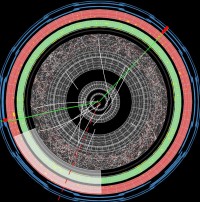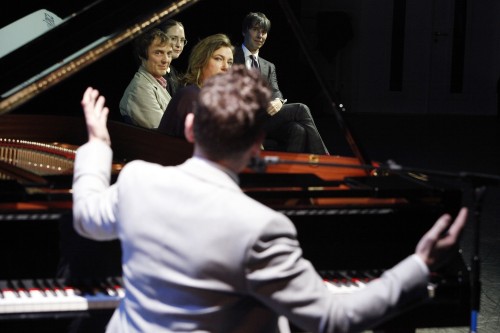Posts by: James Dacey
New York dims its lights for birds

Birds flock over Central Park. (Courtesy: iStockphoto/giovanni1232)
By James Dacey
It’s been a great week for birds – or at least those flying over the state of New York – after state governor Andrew Cuomo pledged to create safer migration routes for our feathered friends. All state buildings will now have to comply with a national US initiative that seeks to curb levels of light pollution, which can disorient birds and lead to huge numbers of avian deaths by “fatal light attraction”.
Many species of bird rely on the light from star constellations to help them navigate during spring and autumn migrations. Unfortunately, artificial light sources can throw the animals off course, and light reflected from glass can cause the birds to smack into windows, walls, floodlights and other hard surfaces. It is estimated that as many as a billion birds succumb to this cruel end each year in the US alone, according to the US Department of Agriculture.
View all posts by this author | View this author's profile
IYL 2015 gets Swiss design makeover
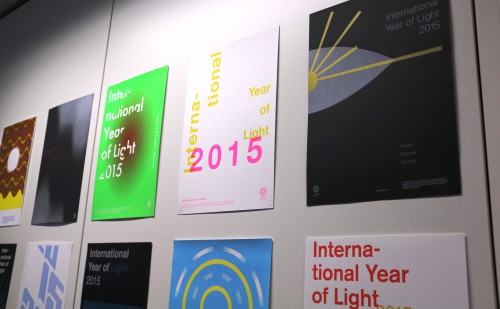
IYL 2015 is the theme of this student poster project.
By James Dacey
One of the big aims of the International Year of Light (IYL 2015) is to take scientific ideas out of the lab to show the world just how inspiring and useful they can be. In the process, it can forge relationships between different communities, including scientists, engineers, artists, journalists, architects, politicians, aid workers…the list goes on.
Here in Bristol, where Physics World is produced, we’ve seen a fantastic local example of this by way of an art project at the University of the West of England (UWE). Second-year graphic-design students were set the brief of creating posters themed on IYL 2015. Last night we hosted an evening at IOP Publishing headquarters to showcase the students’ work and to let them find out more about science publishing.
View all posts by this author | View this author's profile
Astronomers fill supervoid in their knowledge
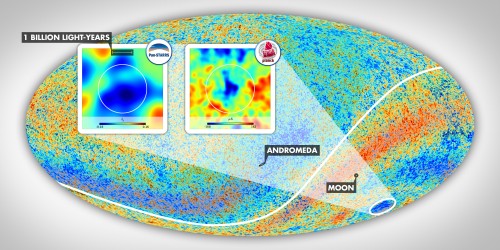
The cold spot (bottom right) resides in the southern galactic hemisphere. (Courtesy: ESA Planck collaboration)
By James Dacey
Astronomers believe they may finally be able to explain the origin of the “cold spot”, a glaringly large cool region in the cosmic microwave background (CMB). Maps of the CMB, such as that created by the Wilkinson Microwave Anisotropy Probe (WMAP) and more recently by the Planck mission, reveal the distribution of radiation left over after the Big Bang. When in 2004 researchers noticed this cold spot on the map, they soon realized it was either a sign of exotic physics linked to the Big Bang itself or it was caused by some sort of structure in the foreground between the CMB and the Earth.
View all posts by this author | View this author's profile
Guide to the solar eclipse
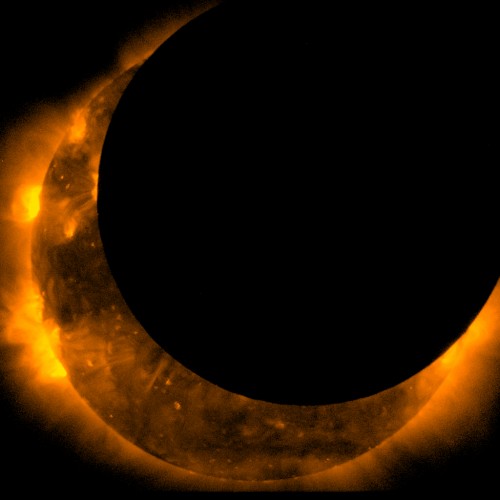
Solar eclipse of 2012, which darkened parts of the US and south-east Asia. (Courtesy: JAXA/Hinode)
By James Dacey
On Friday, our old friend the Moon will swing by to remind us that she’s not just there to reflect the Sun’s light; she can sometimes block it out too. A total solar eclipse will be visible to those lucky few people living in the Faroe Islands or the Norwegian archipelago of Svalbard. Many others across Europe, North Africa and Russia will be treated to the (almost as good) spectacle of a partial solar eclipse.
View all posts by this author | View this author's profile
Personal views on the International Year of Light
By James Dacey
“In the beginning there was light – the Big Bang,” said Steve Chu, talking on Monday at the UNESCO headquarters in Paris during the opening ceremony of the International Year of Light and Light-based Technologies (IYL 2015). Chu – a Nobel-prize winner and former US energy secretary – was among a smorgasbord of speakers at the two-day event, which brought together scientists, artists, politicians and many others with a particular interest in light and its applications.
Being a journalist, I was at the event with my own light-based technology, the humble SLR camera. I was recording a series of interviews with people at the event, including Chu, to get their thoughts on what the year of light means to them. As I’ve mentioned in a previous article, the fact that “light” is such an all-encompassing theme can also make it difficult to get a handle on what IYL 2015 is all about. I hope that the resulting video – to be published on physicsworld.com next week – will bring clarity to some of the initiatives and projects in the spotlight this year.
Lighting up a mid-winter Bath
By James Dacey
In what could be described as the West Country’s answer to Diwali, the city of Bath in the UK has just hosted an eight-day festival of light, featuring colourful public artworks based on lighting technologies. “Illuminate 2015” was one of the first events on the calendar in this International Year of Light, the UNESCO-supported celebration of light science and its applications. I popped along to the event last Thursday to find out what it was all about and I’ve put together this short film, which includes the event’s creative director Anthony Head explaining what the festival is all about.
“It’s a subtle introduction to experimenting with science,” says Head, referring to the fact that many of the exhibits are interactive and involve some playful experimentation. One such exhibit, called “Light Painting”, invited the general public to create images that were then projected onto some of the local buildings. Another exhibit, called “Sonic: Sullis”, enabled people to create sounds and light projections by simply disturbing water contained in a box.
View all posts by this author | View this author's profile
Become a CERN physicist in your bedroom
By James Dacey
Who discovered the Higgs boson? Was it Peter Higgs and a combination of other great minds? The experimentalists at CERN who analysed reams of data? The magnificent machinery of the Large Hadron Collider (LHC) itself? By the time that the next great breakthrough in particle physics comes along, the debate about who makes the discovery could become even more complex. That’s because a new citizen-science project is encouraging anyone with an Internet connection to search for new curiosities in the Higgs data.
“Higgs Hunters” launched this week and invites the public to sift through collision images from the LHC’s ATLAS detector. The task at hand is to look for the paths of charged particles that seem to appear out of thin air in what are known as off-centre vertices. As explained on the Higgs Hunters website, “some scientists think the Higgs could break apart into exotic particles entirely new to science”. On the Higgs Hunters website, citizen scientists help to count the number of particle tracks and can notify the science team if they spot anything out of the ordinary.
View all posts by this author | View this author's profile
What makes the perfect song?
By James Dacey
There was a telling moment early on at the event I attended last night when science writer Philip Ball was asked to name his “perfect song”. With a slightly bemused look, Ball picked a tune that I’m pretty sure few in the audience had heard of – “The Most Wanted Song”, which was co-written by a neuroscientist to incorporate the musical elements that people find most pleasing to the ear. Give the tune a listen and you’ll realise that it is a horrible saccharine track that you’ll quickly want to turn off. Of course, the point of the song – and Ball’s choice – was to ridicule the idea that you can create beautiful music with a formula.
Ball was part of a panel discussion at the Royal Opera House in London on “What makes the perfect song?”. He was joined by physicist-turned-opera singer Christine Rice and musicologist Maria Witek, and the event was chaired by the physicist, broadcaster and former pop star Brian Cox (by angela). While the panellists were unanimous in their belief that music is a complex emotional thing that cannot be fully explained by physics, they did have some fascinating insights into the science of song.
View all posts by this author | View this author's profile
Space bonanza to land in Manchester

The Age of Starlight will catch both the eyes and the minds of the audience. (Courtesy: ESO/P D Barthel)
By James Dacey
Whatever punters make of the Manchester International Festival (MIF) next year, they certainly won’t be able to accuse it of thinking small. Among the first commissions announced today is a “world-first show about the origin of the universe and everything within and without it”.
The Age of Starlight will be presented by the physicist and TV personality Brian Cox, who will tell the story of the unlikely events that have led to our existence. Details of the show are still scarce but we do know that the space bonanza will feature computer-generated imagery created by the Oscar-winner Tim Webber and the special-effects team behind the film Gravity. The event will be brought to life with technologies developed by Magic Leap, a Florida-based IT company that specializes in “magical” computing solutions.
View all posts by this author | View this author's profile
Proton-beam therapy explained
By James Dacey
The story of young brain-tumour patient Ashya King has gripped the British public over the past few weeks, with every twist and turn covered extensively in the media. In a nutshell, the five year old was removed from a hospital in Southampton at the end of August by his parents, without the authorization of doctors. They wanted their son to receive proton-beam therapy, which was not offered to them through the National Health Service (NHS). The family went to Spain in search of the treatment, triggering an international police hunt that subsequently saw the parents arrested before later being released.
The drama was accompanied by a heavy dose of armchair commentary, with Ashya’s parents, the hospital in Southampton and the police all receiving both criticism and praise. Even the British Prime Minister, David Cameron, got caught up in the affair, as he offered his personal support to the parents. To cut a long story short, Ashya’s parents finally got their wish and they have ended up at a proton-therapy centre in the Czech Republic where their son’s treatment begins today.
But what is proton therapy? It is a relatively new medical innovation that shows great promise in the treatment of cancer, though it is only currently available in certain countries. Beams of protons can be directed with precision at tumours in the body – allowing the energy to destroy cancer cells, while causing less damage to the surrounding tissue than is possible with conventional radiation therapies. The treatment, however, is only really useful in specific cases of cancer, such as where is vitally important that surrounding structures are not damaged. And because it is relatively new, there is less information available about how effective it is compared with more established treatments.
View all posts by this author | View this author's profile
